Maternity care survey 2018: national results
National results of the 2018 Maternity Care Survey. Comparisons have been made with the previous iterations of this survey where this is possible.
This document is part of a collection
6. Labour and Birth
Summary
- Just over nine in ten women rated the care they received during their labour and birth positively. This is consistent with results from 2015 but a small decrease from 2013.
- Women were positive about their experiences of person-centred behaviours during labour and birth. They were most positive about being given the opportunity to involve the people that mattered to them (95 per cent).
- A quarter of women were cared for by the same midwife / midwife team as during their antenatal care, however 56 per cent of women reported that they did not mind that they were cared for by a different midwife / midwife team.
- Just over four in five women felt that any concerns they raised were taken seriously and three in four women always received assistance within a reasonable time when they called / asked for it.
Overall Experience
Just over nine in ten women (91 per cent) rated the care they received during their labour and birth as either ‘Excellent’ or ‘Good’ (Figure 6.1). This is consistent with the results from the 2015 survey, but shows a small decrease from 93 per cent in 2013.
Figure 6.1: Overall experience of care during labour and birth in 2018 and over time
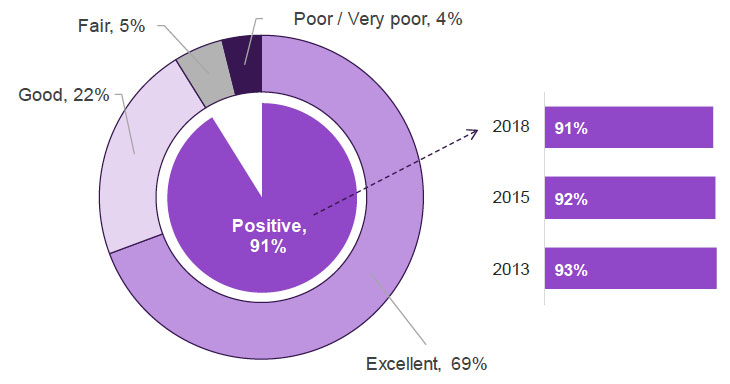
Labour
At the very start of labour, 87 per cent of women felt they were given appropriate advice and support when they contacted a midwife or the hospital. This is consistent with results from 2015 and shows an increase from 85 per cent in 2013.
Almost three-quarters of women (74 per cent) were able to move around and choose the position that made them most comfortable most of the time during labour. This is consistent with responses in previous surveys.
Eighty-seven per cent of women felt they had enough help to cope with their pain during labour which is consistent with results from previous surveys. Looking at this result in more detail, 59 per cent felt they had enough help ‘always’ and 28 per cent felt they had enough help ‘most of the time’.
Birth
The survey asked women what type of birth they had. As shown in Figure 6.2, half of women (50 per cent) experienced a normal vaginal delivery. The remaining half of women were fairly evenly distributed between experiencing an assisted vaginal delivery, a planned Caesarean delivery or an emergency Caesarean delivery. These figures are broadly in line with the provisional national maternity figures for method of delivery in 2018 published by Information Services Division (ISD)[18].
Figure 6.2: Type of birth
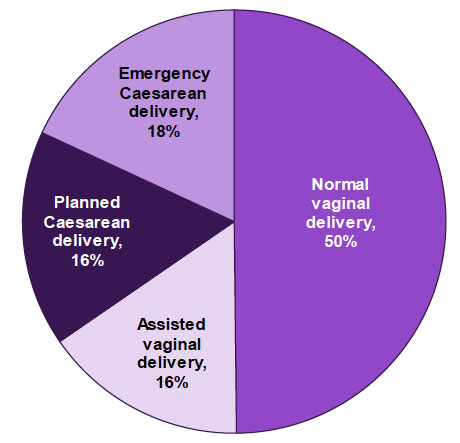
Those who had a vaginal delivery were asked:
- where they gave birth – most women (86 per cent) gave birth on a bed; seven per cent gave birth in a water or birthing pool; and three per cent gave birth on a mat on the floor. The remaining four per cent selected ‘Other’.
- their position for the birth – as shown in Figure 6.3, over two in five women (42 per cent) were lying with their legs in stirrups or held up and one in five women (20 per cent) were lying flat or lying supported by pillows.
Almost nine in ten women (89 per cent) who had an assisted vaginal delivery gave birth whilst lying with their legs in stirrups or held up. Women who had a normal vaginal delivery were more evenly distributed, with 27 per cent lying with legs in stirrups or held up; 25 per cent lying flat / lying supported by pillows; and 21 per cent standing, squatting or kneeling.
The overall pattern is different to that seen in previous years, but this may be linked to a change of wording in the response option relating to stirrups, which was expanded in 2018 to include legs being held up. The increase in women selecting this response, and corresponding decrease in women selecting ‘Sitting / sitting supported by pillows’ or ‘Lying flat / lying supported by pillows’, could reflect the broadening of this response description.
Figure 6.3: Position for the birth by type of birth
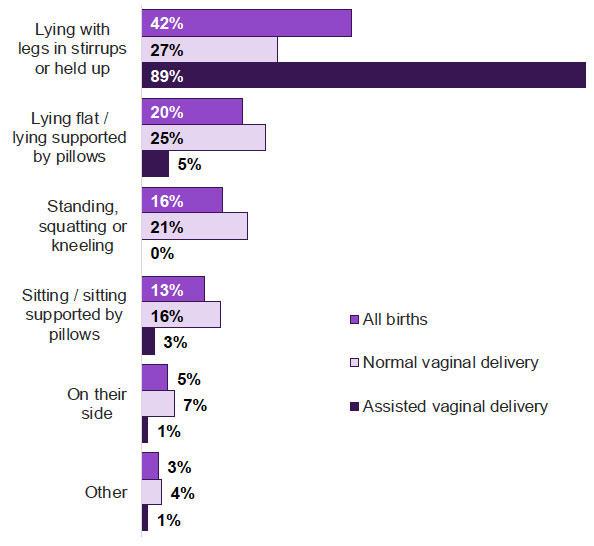
Most women (94 per cent) had skin-to-skin contact with their baby, that is their baby naked directly on their chest or tummy, shortly after the birth.
Person-centred Care
When asked whether the staff caring for them introduced themselves, 85 per cent of women responded that all the staff did. This is consistent with the results from 2015 and is an increase from 81 per cent in 2013 (Figure 6.4).
Figure 6.4: Proportion of women reporting all staff introduced themselves
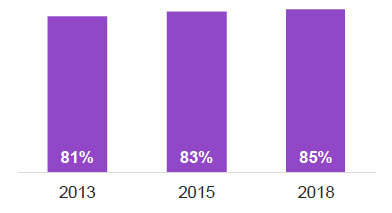
A quarter of women (25 per cent) were cared for by the same midwife / midwife team as during their antenatal care (Figure 6.5). Of those who were not, one in five women (19 per cent) would have liked to have been cared for by the same midwife / midwife team but 56 per cent of women did not mind.
Figure 6.5: Cared for by the same midwife / midwife team as for antenatal care
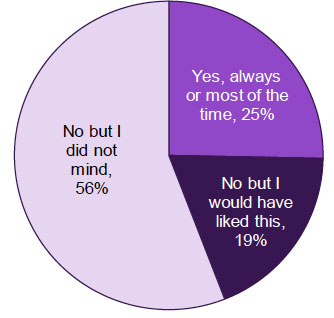
The survey asked women whether they agreed or disagreed with eight statements relating to experiences of person-centred behaviours during labour and birth. As shown in Figure 6.6, women were very positive about these behaviours, with the lowest positive response at 89 per cent for being listened to.
Women were most positive about being given the opportunity to involve the people that mattered to them and being treated with respect and dignity (95 and 94 per cent respectively).
Figure 6.6: Responses to person-centred statements – Labour and birth
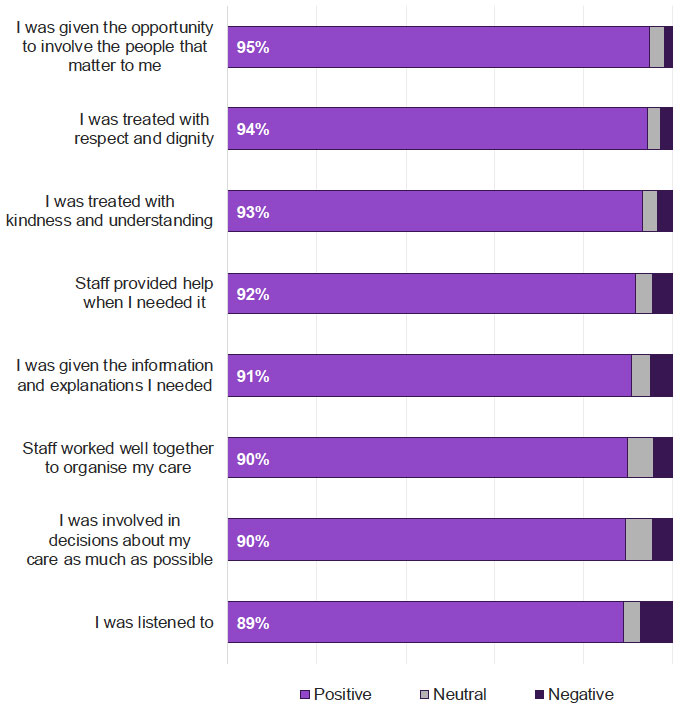
Concerns During Labour & Birth
The survey asked women if they had raised a concern during labour and birth, did they feel it had been taken seriously. Around three in five women (59 per cent) reported that they had raised a concern. Of these women, around four in five (81 per cent) felt that their concern was taken seriously which is consistent with results from previous surveys.
When they called / asked for assistance, around three in four women (74 per cent) always received it within a reasonable time. This is consistent with results from 2015 but is a decrease from 78 per cent in 2013 (Figure 6.7).
Figure 6.7: Proportion of women always receiving assistance during labour and birth within a reasonable time
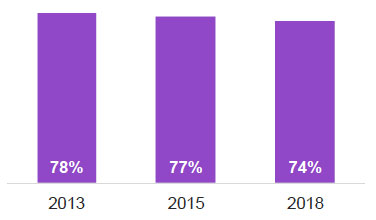
The survey asked women whether they, and / or their partner or companion, were left alone by midwives or doctors at a time when it worried them. Around four in five women (81 per cent) reported that they had never been left alone at a time when it worried them.
Table 2 sets out the proportion of women selecting each stage. Almost one in ten women (9 per cent) were worried due to being left alone during early labour, but only one per cent of women were worried due to being left alone during the birth.
Table 2: Left alone at a time when it worried them[19]
| % |
|
|---|---|
| During early labour |
9 |
| During later stages of labour |
6 |
| During the birth |
1 |
| Shortly after the birth |
6 |
| Not at all |
81 |
Contact
Email: patientexperience@gov.scot
There is a problem
Thanks for your feedback